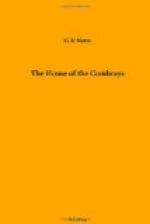D’Ache and Mondejen rushed from the room and bounded across the porch into the courtyard just as the gendarmes burst in at the gate. They would have been caught if a horse had not slipped on the wet pavement and caused some confusion, during which they shut themselves into a barn, escaped by a door at the back, and jumping over hedges and ditches gained a little wood on the further side of the Tortoue brook.
But d’Ache had been seen, and from that day he was obliged to resume his wandering existence, living in the woods by day and tramping by night. He was entirely without resources, for he had no money, but was certain of finding a refuge, in case of need, in this region where malcontents abounded and all doors opened to them. In this way he reached the forest of Serisy, a part of which had formerly belonged to the Montfiquets; it was here that the abandoned mines were situated that had been mentioned to Licquet as Allain’s place of refuge. Though obliged to abandon the Chateau de Mandeville, where, as well as at Rubercy, the gendarmes had made a search, d’Ache did not lack shelter around Bayeux. A Madame Chivre, who lived on the outskirts of the town, had for fifteen years been the providence of the most desperate Chouans, and d’Ache was sure of a welcome from her; but he stayed only a few days.
Mme. Amfrye also assisted him. This woman who never went out except to church, and was seen every morning with eyes downcast, walking to Saint-Patrice with her servant carrying her prayer book, was one of the fiercest royalists of the region. She looked after the emigrants’ funds and took charge of their correspondence. Once a week a priest rang her door-bell; it was the Abbe Nicholas, cure of Vierville, a little fishing village. The Abbe, whose charity was proverbial, and accounted for his visits to Mme. Amfrye, was in reality a second David l’Intrepide; mass said and his beads told, he got into a boat and went alone to the islands of Saint-Marcouf, where an exchange of letters was made with the English emissaries, the good priest bringing his packet back to Bayeux under his soutane.
D’Ache could also hide with Mademoiselle Dumesnil, or Mlle. Duquesnay de Montfiquet, to both of whom he had been presented by Mme. de Vaubadon, an ardent royalist who had rendered signal service to the party during the worst days of the Terror. She was mentioned among the Normans who had shown most intelligent and devoted zeal for the cause.
Born de Mesnildot, niece of Tourville, she had married shortly before the Revolution M. le Tellier de Vaubadon, son of a member of the Rouen Parliament, a handsome man, amiable, loyal, elegant, and most charmingly sociable. She was medium-sized, not very pretty, but attractive, with a very white skin, tawny hair, and graceful carriage. Two sons were born of this union, and on the outbreak of the Revolution M. de Vaubadon emigrated. After several months of




